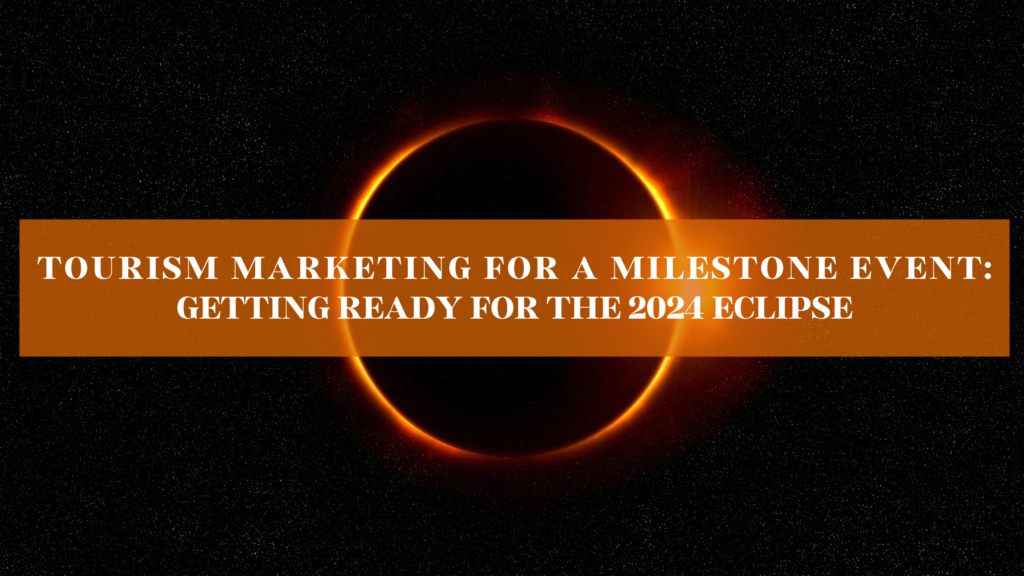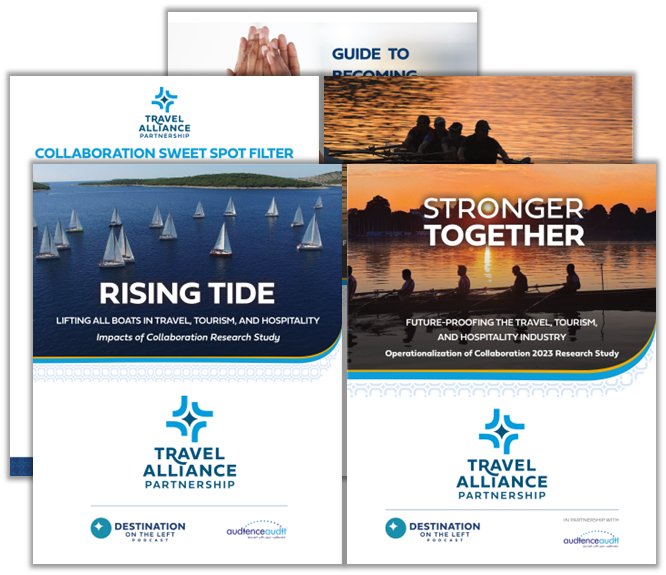Tourism Marketing for a Milestone Event: Getting Ready for the 2024 Eclipse
Milestones are major events that mark significant change or a new development. Milestones are also markers along the way to know that you are progressing on your path or towards your goal. A milestone event such as a big anniversary historical event, or astrological event like the total solar eclipse offers a community the opportunity to reach new audiences, build exposure and set themselves up for future visitation.
Rochester, New York, the community where I work, will be on the path of totality for the 2024 solar eclipse. The following milestone markers will help tourism marketers take advantage of this milestone event as the launchpad for future business.
Find all of the communities on the path of totality in 2024.

Milestone One – Planning
The first marker along the way is planning. We don’t want to let the eclipse happen to us – we want to be actively engaged with the opportunity and to do that we must have a plan. Praying that it all goes well and will benefit us will not work.
Focus your plan in four areas – partnerships, positioning, delivery and outreach.
- Partnerships: Who are my collaborative partners?
- Positioning: Who are we and how do we stand out?
- Delivery: How do we surprise & excite our visitors, so they tell their friends and family and return for a future visit?
- Outreach: How do we reach the right audiences and how do we help them plan their experience?
Milestone Two – Partnerships
Partnerships and collaborations are paramount to success, especially when you have a milestone event coming to your area.
To figure out who to partner with, consider these steps:
- Identify your biggest opportunity. Are you a hotel hoping to get your share of the room nights, or a restaurant looking to fill your dining room or a museum looking to see additional visitation – wherever you find your biggest opportunity is where you should look for partners who can help you realize that opportunity.
- Define your goals with the partnership and how partnering can expand your ability to reach those goals.
- Create a list of potential partners. Brainstorm as many as possible. Do not limit yourself. Your partners may be your competitors – this is what I like to call co-opetition. Some of the most powerful collaborations have happened when perceived competitors’ partner to do something together that they could not accomplish on their own.
For example, perhaps there is a group of restaurants who usually compete for customers that come together to market themselves collectively under a creative eclipse theme, serving astrological-inspired dishes, cocktails, and desserts. Or maybe there is a collaboration between the chefs to create a food crawl where each stop compliments the last.
Rochester created an eclipse taskforce with over 200 stakeholder members. If your community has a task force, this would be a great place to start seeking partners. If they don’t have a task force, check out Rochester’s member list to get inspired about the types of partners you may reach out to.
A Collaboration Framework
When evaluating partners and building successful collaborations, consider the 3-C Framework for Collaboration I developed through research, countless podcast interviews and first-hand experience. The 3-C Framework includes Communication, Commonality and Commitment.
These questions can be a guide when evaluating a possible partner for a collaboration.
Communication
- Is there a shared vision?
- Are realistic expectations established?
- Is there a plan for communication?
- Are roles for each partner identified?
Commonality
- Will the collaboration benefit all of the partners?
- Are there strong champions for the collaboration?
- Are the goals identified?
Commitment
- Is there accountability in place for collaborative partners’ contributions?
- Are leadership teams well-informed for all participating partners?
- Is there full commitment by all participants?
- Are the resources available to see the collaboration through?
Download our collaboration sweet spot filter. The tool will give you a guideline for thinking through your collaboration, the partners you are working with and a checklist for success.
Milestone Three – Positioning
Your positioning answers the Why and the What – the why answers the question why the visitor will pick your destination/attraction/experience and the what answers the question of what makes your destination/attraction or experience stand out from other choices.
Macro-level
You can think about this at the macro-level in the way that the Rochester Solar Eclipse Task Force has positioned the area.
The 2024 eclipse, starting in Mexico and traveling northeast, will hit Rochester but miss all other major East Coast cities, including Boston, New York, Philadelphia, and Washington, DC. As the closest city to the path of totality with a major science center, Rochester will be in the international spotlight.
In this example, Rochester is answering the why with its geographical location within the path of totality, noting that all the major east coast cities will miss it. The community answers the what with the note of being the closest city to the path of totality with a major science center. The science center will ultimately provide a better experience for visitors as they plan for educational events that coincide with the eclipse.
Micro-level
In addition to the macro-level, you also need to think about this at the micro-level for your specific destination/business or attraction. How are you positioned within the larger region? Once a visitor decides on Rochester, why should they consider adding your experience to their itinerary and what makes you stand out?
On episode 159 of my podcast Destination on the Left, I was fortunate to interview Brook Kaufmann from Visit Casper Wyoming in 2018 shortly after they had been in the path of totality for the 2017 eclipse. Prior to the eclipse they had gone through an extensive re-positioning of the destination. Brooke shared through this process they dug into what made the destination stand out. They recognized two things:
- They were the one and only Casper – there is no other town in the world with the same name (imagine that?)
- They are on the way to several major national parks including Yellowstone and Teton.
Leaning on these two points, they developed the Only One Casper campaign and leaned into things that you can only do in Casper – the things that were truly unique experiences. Brooke shares the entire story of their positioning and how they managed a committee that turned into an organization to handle the 10’s of thousands of visitors that descended on the small community for the 2017 eclipse. She reported that because of the extensive pre-planning and collaboration that her community engaged in, the eclipse was a huge success and brought them 225 million media impressions and a visitor study showed that 35% of the visitors who had never been to the destination before said they planned to return for a future visit.
Milestone Four – Delivery
This is where you can shine. Our goal is to create word-of-mouth marketing and to inspire return visitation. We don’t want to think of the milestone of the 2024 eclipse as the end point- if we do it right, it is just the beginning. The partnerships and programs that you create for the eclipse should help you with future business too – not just the 5-7 days that eclipse seekers are in your area.
How do we inspire word of mouth marketing and return visitation? We must surprise and excite our visitors. They will come to your area for the eclipse because you offer the best viewing and their decisions are being made mostly on that criteria – but to get them to return we want to show them why this area is so special and why it deserves a return visit.
This is a brief checklist of the types of things you should be thinking about for delivering an experience that surprises and excites. This is not an exhaustive list, but I hope it gets you thinking about the areas where you can have an impact on delivering the best experience possible for our eclipse guests.
Logistics:
- How are we going to move people around the city?
- How are we going to keep them safe?
- How are we going to provide emergency management services?
The Details:
- Parking & traffic considerations
- Street light sensors – can we turn them off?
- Wayfinding Signage
- Dark sky compliant lighting (amber vs white lights)
Content/Programming:
- Storytelling
- Themed events
- Moonlight dinners
- Solar walks
- Special edition beverages
- How do we enhance the 3 minutes and 38 second once-in-a-lifetime experience?
Special touches:
- Frontline staff training
- Eclipse glasses
- How do we make sure the guests have the best experience?
Some of these ideas came from my guest in episode 288, Michael Marlin, who is a speaker, author, and consultant in the astro tourism space. He told me that unlike space tourism where people seek to go up to look down, astro tourism is where people go to a place to look up.
Milestone Five – Outreach
Understanding the customer journey will be important for your outreach plans. They are on different planning timelines. Those looking for hotels are looking over a year in advance, while activities and things to do may be planned 60-90 days before your event.
When a visitor arrives to view the Eclipse, they are at the start of their physical journey. But the visitor journey begins much earlier – from the first time they heard about the 2024 eclipse.
The Visitor Journey is broken into 5 phases:
Dreaming – it starts with scrolling through Instagram on their lunch break, reading a story in a publication, or talking with family about the places they’d like to see and events they’d like to attend.
Planning – then comes researching details such as routes, places to stay, and things to do.
Booking – next, they take their hard-earned dollars and put them behind their plans, purchasing tickets and possibly securing hotels.
Experiencing – finally, it’s time. They arrive in Rochester for the 2024 Eclipse. That experience lives for longer than the day(s) they spend there.
Sharing – their experience is over, but the memories live on. They live on when they talk about it with their friends. They live on when they share photos on social media. And they live on as the spark of inspiration that prompts others to begin dreaming of a visit.
We are building the road that goes from the first smartphone search, the first article read to the last picture posted. The road that leads to your destination for the 2024 Eclipse.
Author
Related Posts
10 Must-Listen Podcasts for Travel, Tourism & Hospitality Professionals
I’ve had the joy of hosting Destination on the Left—an award-winning podcast spotlighting the travel, tourism, and hospitality industry—since 2016. My team and I believe…
How Tourism Brand Ambassadors Elevate Your Destination Story
In today’s world, it can seem like everything in marketing and sales has changed. But the one thing that hasn’t changed is the value of...
